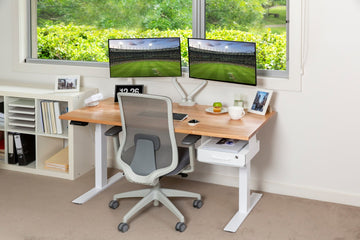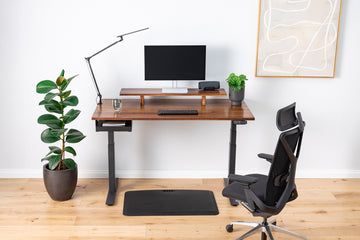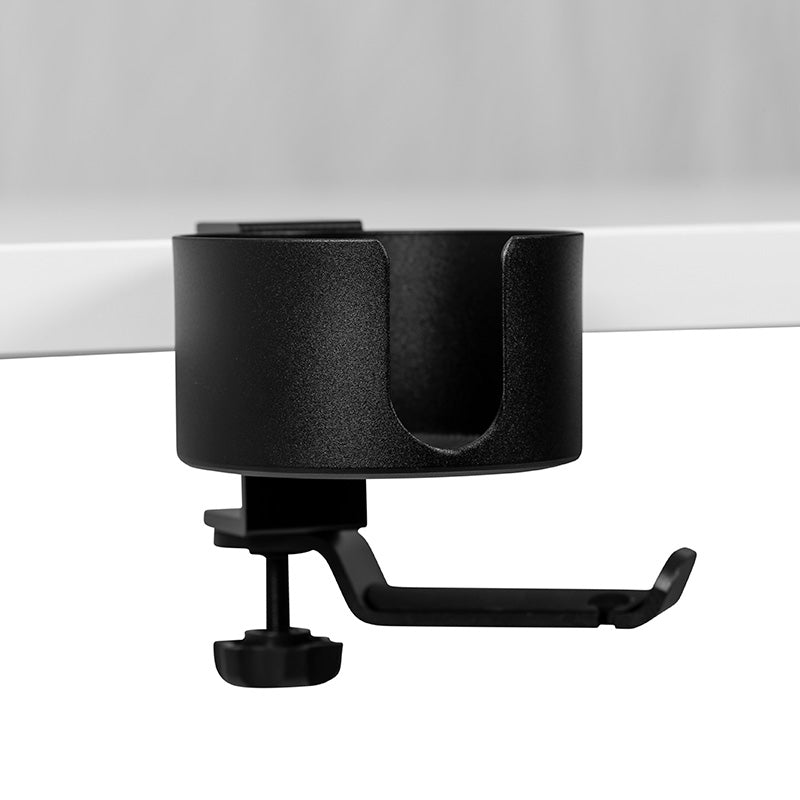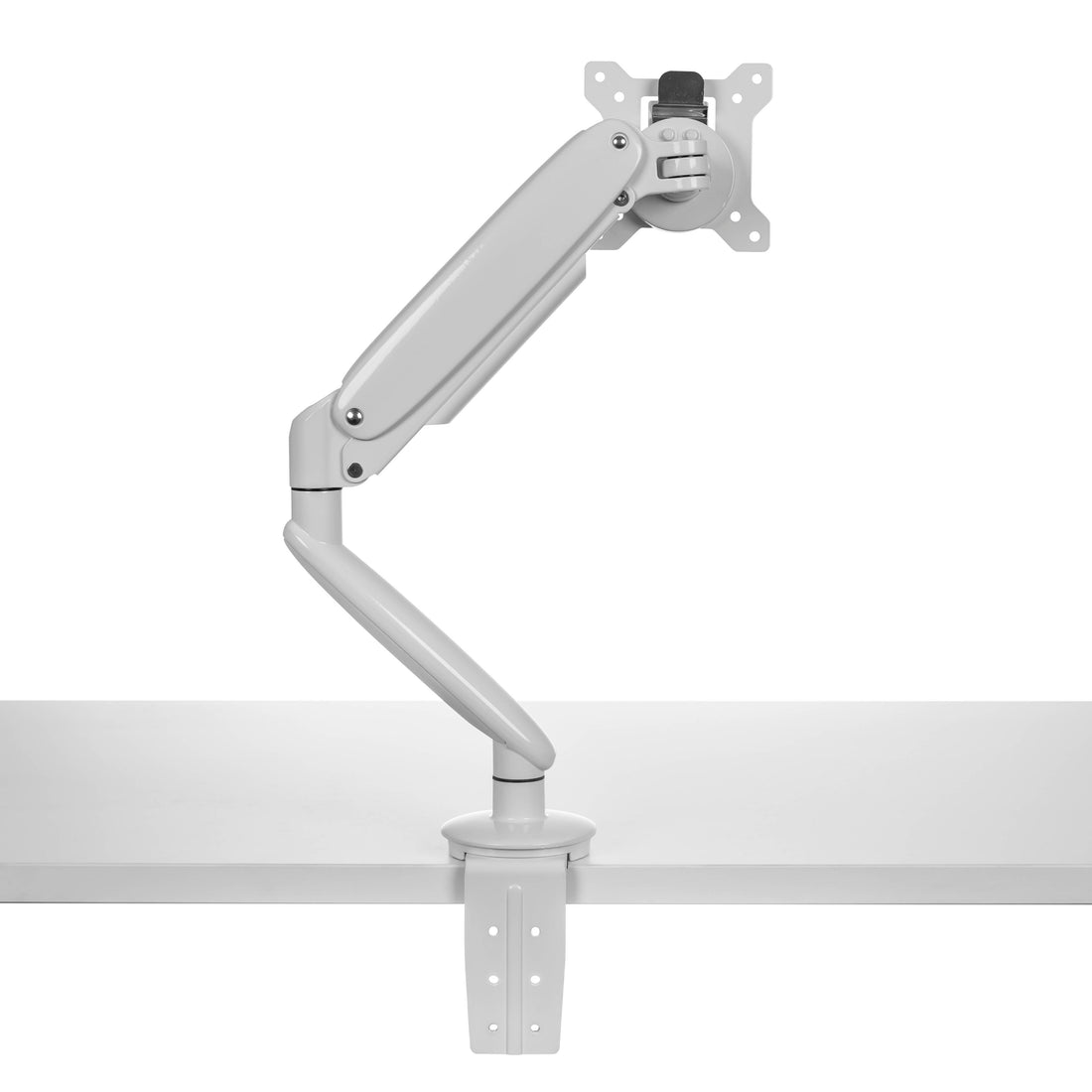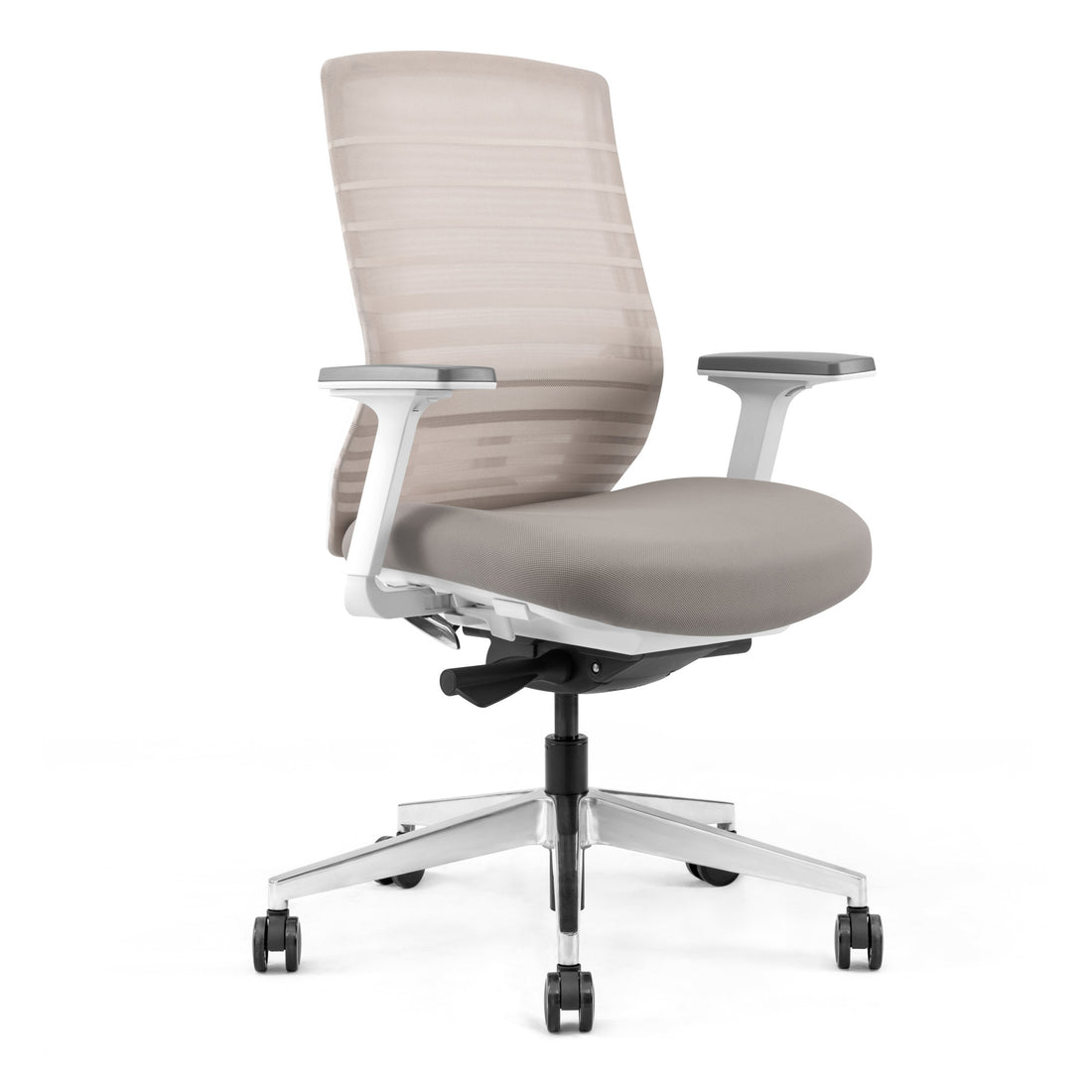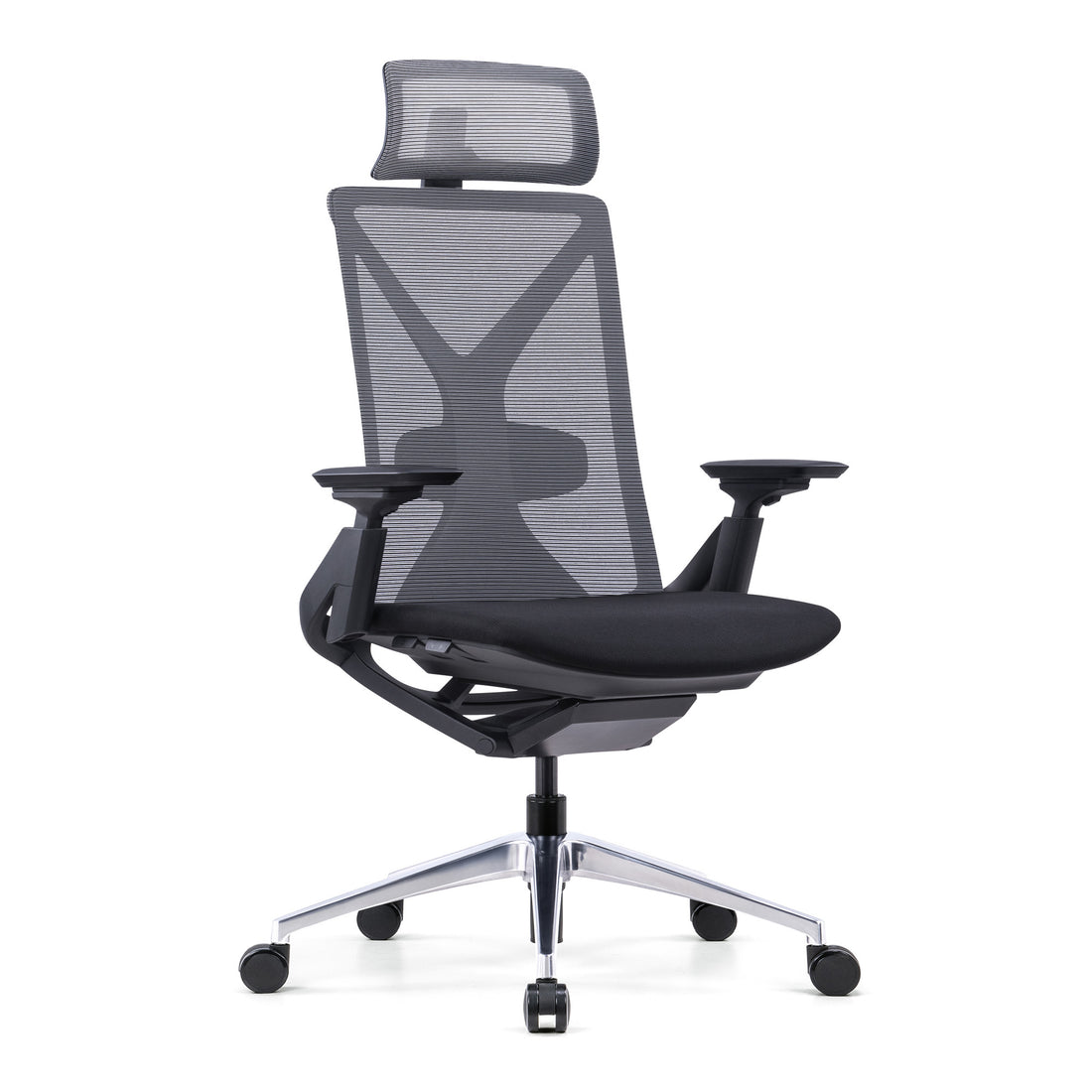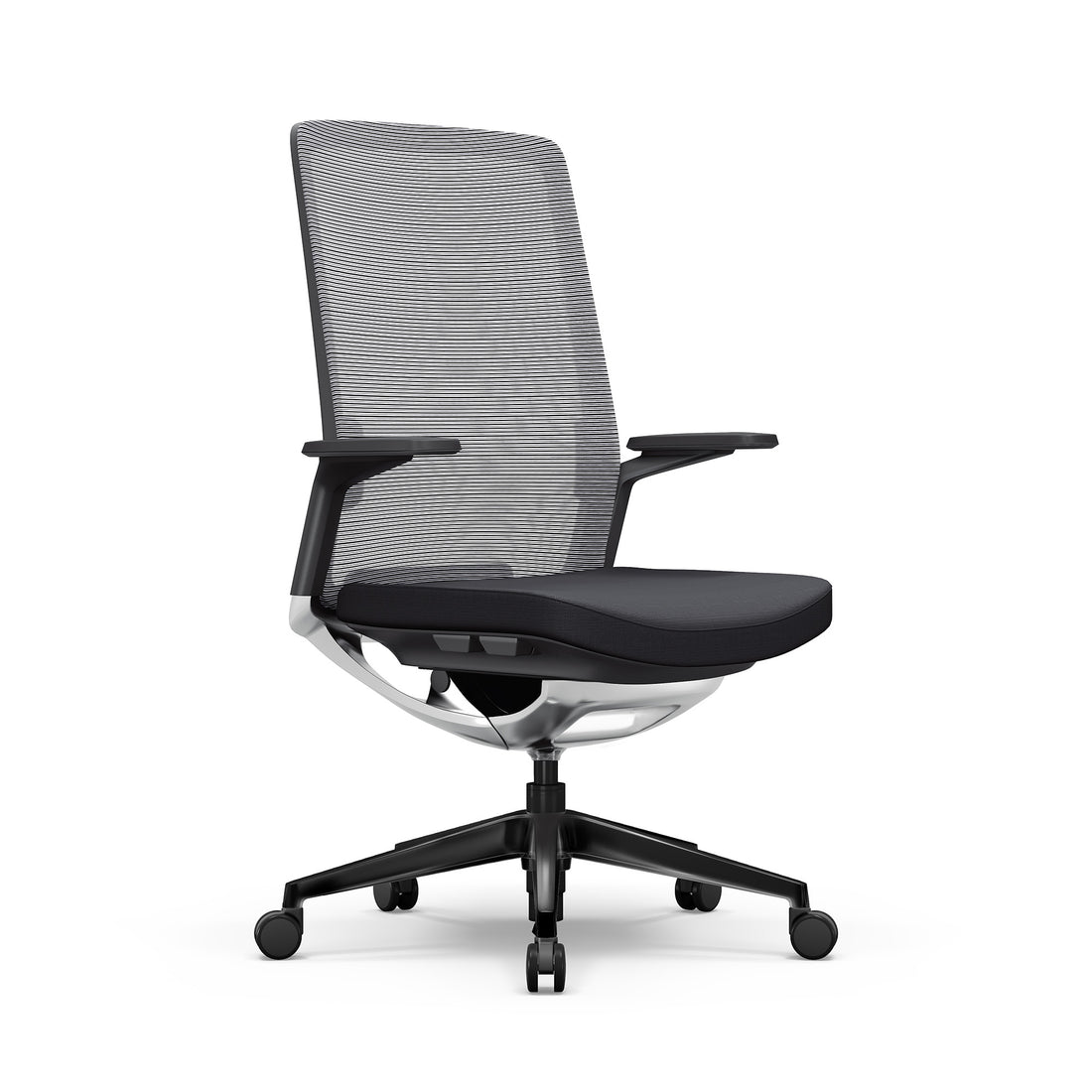The importance of proper seating cannot be overstated in our current environment. Ergonomic chairs have risen in popularity as the go-to solution for anyone looking to enhance comfort, improve posture, and increase productivity. Paired with a standing desk, they offer a dynamic combination that supports movement and optimal sitting posture. However, what exactly makes a chair ergonomic, and how does it differ from the traditional office chair?
Ergonomic chairs are more than just a luxury; they are necessary when prolonged sitting is common. Whether you work in an office, at home, or spend hours gaming, an ergonomic chair supports your body to reduce strain, prevent injury, and enhance comfort. This guide will walk you through the essential features of ergonomic chairs, their benefits, and what makes a chair ergonomic compared to other types of chairs, such as task chairs. Additionally, you’ll learn about the impact of ergonomic chairs on workplace health and which occupations benefit most from their use.
What Makes a Chair Ergonomic? Definition and History
An ergonomic chair is specifically designed to support the natural posture and movements of the human body, minimizing the risk of discomfort and injury. Unlike standard chairs, ergonomic chairs are built with adjustable features, such as seat height, lumbar support, armrests, and backrest angles, allowing users to customize the chair to their unique body shape and work environment.
These chairs are essential in promoting good posture by aligning the spine correctly, reducing strain on the back, neck, and shoulders. The goal of an ergonomic chair is to provide a comfortable seating experience that supports long periods of sitting while reducing the risk of musculoskeletal issues.
The history of ergonomic chairs dates back to the early 20th century when the concept of workplace ergonomics began to take shape. Initially, the focus was on improving the design of industrial tools and machinery to prevent injuries. Over time, as office work became more prevalent, the need for ergonomically designed office furniture, particularly ergonomic office chairs, became apparent.
Understanding Ergonomics of a Chair
The ergonomics of a chair involve several key principles aimed at supporting the body naturally and healthily. One primary goal is maintaining the spine’s natural curve, which is essential for preventing back pain. An ergonomic chair achieves this by offering adjustable components that allow the user to customize the chair to their body’s unique shape and size.
For example, the seat height should be adjustable so the user’s feet are flat on the floor, with the knees at a 90-degree angle. This position ensures that the body's weight is evenly distributed, reducing strain on the lower back and legs. Additionally, the backrest of an ergonomic chair is designed to provide lumbar support, which is crucial for maintaining the spine's natural curve.
Importance of Proper Support and Adjustability
Proper support and adjustability are critical factors distinguishing an ergonomic chair from a standard office chair. The ability to adjust the chair’s height, depth, and tilt ensures the user can find a comfortable and supportive position.
Customization for Different Body Types
No two bodies are alike, and a chair that works well for one person may not be ideal for another. This is where the customization features of an ergonomic chair come into play. Adjustable ergonomic chair features such as seat depth, height, and tilt allow the chair to be tailored to the individual’s body type, helping to counteract the effects of bad desk ergonomics and ensuring that the chair provides the best possible support, regardless of the user's size or shape.
Key Features of Ergonomic Chairs

The value of an ergonomic chair lies in its features, each designed with the user’s comfort and health in mind. Knowing what an ergonomic chair is and its key features can help you make an informed decision when choosing the right chair for your needs.
1. Adjustable Seat Height
One of the most basic yet essential features of an ergonomic chair is the adjustable seat height. This allows the user to position their feet flat on the floor, with their knees at a 90-degree angle. Maintaining this position is crucial for good posture, as it ensures that the body’s weight is evenly distributed and that there is no unnecessary strain on the lower back.
An ergonomic chair should have a pneumatic adjustment lever that makes raising or lowering the seat easy. Ideally, the seat height should range from about 16 to 21 inches off the floor, accommodating most users. When seated correctly, your thighs should parallel the floor, and your feet should rest comfortably on the floor or a footrest.
2. Lumbar Support
Lumbar support is a critical feature of ergonomic chairs that cannot be overlooked. The lumbar spine has a natural inward curve, and sitting for long periods without support for this curve can lead to slouching, which flattens the natural curve and strains the structures in the lower spine.
An ergonomic chair with adjustable lumbar support allows the user to customize the height and depth of the support to fit the natural curve of their spine. This helps maintain good posture and prevents the lower back from straining, reducing the risk of developing chronic back pain.
3. Adjustable Armrests
A useful ergonomic chair feature is to have adjustable armrests. Ideally, armrests should be adjustable in height and width so that the user’s arms can rest comfortably with their shoulders relaxed. The armrests should also allow the elbows to stay close to the body and be at a 90-degree angle to the forearm.
Properly adjusted armrests can take some of the strain off the neck and shoulders, which is useful for people who spend a lot of time typing or using a mouse. Ergonomic armrests should not interfere with movement or the positioning of the chair. In some designs, armrests are adjustable in angle or can be moved out of the way when not needed.
4. Seat Depth and Width
An ergonomic chair's seat depth and width are essential for ensuring that the chair provides adequate support. The seat should be wide enough to support the user comfortably and deep enough to support the thighs without putting pressure on the back of the knees. Typically, the seat width should be between 17-20 inches, and the depth should be such that the user can sit with their back against the backrest while leaving about 2-4 inches between the back of their knees and the seat.
A seat that is too deep can cause circulation problems, while a seat that is too shallow can lead to discomfort and poor posture. Some ergonomic chairs offer adjustable seat depths to accommodate different leg lengths.
5. Recline and Tilt Mechanisms
An ergonomic chair's recline and tilt mechanisms are helpful in relieving pressure on the spine and promoting movement. These features allow the user to adjust the backrest angle and the seat's tilt, providing better back support and reducing the risk of back pain.
The ability to recline helps to take some pressure off the lower back, which can be beneficial during long periods of sitting. A tilt mechanism allows the user to rock or tilt the chair, promoting circulation and reducing fatigue. The best ergonomic chairs will have a tilt tension control that allows users to adjust the resistance to suit their preferences.
6. Material and Build Quality
The material and build quality of an ergonomic chair are also important considerations. High-quality materials ensure durability and comfort, while breathable fabrics can prevent discomfort caused by heat and moisture. The frame should be sturdy and stable, with a solid base that prevents tipping.
Regarding the seat and backrest, look for materials that are firm enough to provide support and have enough padding to be comfortable. Mesh backrests are popular because they allow air to circulate, keeping the user cool. Leather or high-quality fabric covers can also be durable and easy to clean, but the choice ultimately depends on personal preference.
Ergonomic Chair Benefits
Investing in an ergonomic chair is not just about comfort—it's about enhancing overall well-being and productivity. The ergonomic chair benefits extend beyond their immediate comfort, influencing long-term health and workplace efficiency.
1. Enhanced Comfort and Posture
Ergonomic chairs enhance comfort by supporting the body’s natural posture, a key aspect of the ergonomics of a chair. This is achieved through adjustable features that allow the chair to conform to the user’s body rather than forcing the user to adapt to the chair. By promoting a healthy sitting posture, ergonomic chairs help prevent slouching, which can lead to back pain and other musculoskeletal issues.
The enhanced comfort of ergonomic chairs can also reduce fatigue, allowing users to remain focused and productive throughout the day. When properly supported, the body uses less energy to maintain a sitting position, improving overall comfort and reducing the likelihood of developing chronic pain.
A review titled "A Systematic Review of Research on Sitting and Working Furniture Ergonomics from 2012 to 2022: Analysis of Assessment Approaches" published in “Heliyon” analyzed research on ergonomic furniture over a decade. This review highlighted the effectiveness of ergonomic chairs in reducing discomfort and improving workplace efficiency. The study underscores how critical it is for workplaces to invest in properly assessed ergonomic furniture to enhance employee well-being and productivity.
2. Reduction of Back Pain and Strain
One of the most significant ergonomic chair benefits is reducing back pain. Prolonged sitting, especially in a poorly designed chair, can lead to lower back pain due to the pressure placed on the lumbar spine. Ergonomic chairs address this issue by providing proper lumbar support, which helps maintain the spine’s natural curve and reduces strain on the lower back.
Studies have shown that ergonomic chairs can significantly reduce back pain and discomfort. For example, a systematic review, “The effects of chair intervention on lower back pain, discomfort and trunk muscle activation in office workers,” published in the “International Journal of Occupational Safety and Ergonomics” (JOSE), found that ergonomic chairs reduced lower back pain and promoted better muscle activation, leading to improved posture and reduced fatigue.
3. Increased Productivity and Focus
Comfortable seating can directly influence productivity. An ergonomic chair minimizes distractions caused by discomfort, allowing the user to focus better on their tasks. A study, “The effectiveness of a chair intervention in the workplace to reduce musculoskeletal symptoms. A systematic review,” published in “BMC Musculoskeletal Disorders,” found that ergonomic workplace interventions can significantly improve workplace well-being and productivity.
When employees are comfortable, they are more likely to remain focused on their work, which can lead to higher productivity levels. Additionally, reducing physical discomfort can lead to fewer breaks, allowing employees to stay on task longer.
4. Long-Term Health Benefits
The long-term health benefits of using an ergonomic chair cannot be overstated. Regular use can prevent chronic conditions such as back pain, neck strain, and repetitive stress injuries, contributing to better health and quality of life.
What Is the Difference Between an Ergonomic Chair and a Task Chair?
You may encounter ergonomic and task chairs when shopping for office chairs. Understanding what is the difference between an ergonomic chair and a task chair is important, as they differ significantly in design, features, and intended use. While both types of chairs are designed for use at a desk, ergonomic chairs offer more advanced support and adjustability than task chairs.
Overview of Task Chairs
Task chairs are typically more straightforward in design and may lack the advanced adjustable features of ergonomic chairs. They are generally intended for short-term use and may not provide the same level of support. Task chairs are often used in settings where employees do not spend long periods sitting, such as conference rooms or reception areas.
Task chairs are usually lightweight and easy to move, making them a practical choice for environments where flexibility is needed. However, they are not designed for prolonged sitting and may not provide the same level of comfort and support as an ergonomic chair.
Comparative Analysis: Ergonomic vs. Task Chairs
| Feature | Ergonomic Chair | Task Chair |
| Adjustability | High (seat height, armrests, lumbar support, tilt) | Low to Moderate (basic adjustments) |
| Lumbar Support | Integrated and adjustable | Often lacking or minimal |
| Comfort | Designed for long-term comfort with various customizable features | Basic comfort for short-term use |
| Material and Build Quality | High-quality materials designed for durability and comfort | Basic materials, may wear out faster |
| Price | Generally higher due to advanced features | Lower, designed for budget-conscious buyers |
The key difference between ergonomic and task chairs is their adjustability and support. Ergonomic chairs are designed for long-term use and offer a range of adjustable features that allow the chair to be customized to the user’s body. In contrast, task chairs are typically less adjustable and may not provide the same level of support, making them less suitable for prolonged sitting.
Which Chair Is Right for You?
Choosing between an ergonomic chair and a task chair depends on your needs. An ergonomic chair is likely better if you spend long hours sitting due to its advanced support and customization options. However, a task chair may suffice if your seating needs are temporary or limited.
An ergonomic chair is a worthwhile investment for those who value comfort and health, especially in a professional setting where prolonged sitting is common. On the other hand, a task chair might be more appropriate if you are looking for a budget-friendly option for occasional use.
Standing Desks and Ergonomic Chairs: A Perfect Combination?
As more people become aware of the health risks associated with prolonged sitting, the popularity of standing desks has surged. However, the need for a comfortable and supportive chair remains crucial, even with a standing desk, to address potential issues like standing desk back pain. Combining a standing desk with an ergonomic chair offers the best of both worlds—promoting movement while also ensuring proper seating posture, which is essential for preventing discomfort and strain.
Benefits of Combining Standing Desks and Ergonomic Chairs
Using a standing desk with an ergonomic chair allows users to switch between sitting and standing throughout the day, reducing the risks associated with prolonged sitting. This combination can lead to better circulation, reduced fatigue, and improved posture.
One primary benefit of using a standing desk and an ergonomic chair is the ability to move freely between different positions. This variety of movement is essential for maintaining overall health, as it prevents the stiffness and discomfort resulting from staying in one position for too long.
How Ergonomic Chairs Enhance the Standing Desk Experience
An ergonomic chair complements a standing desk by providing a comfortable seating option when needed. It ensures the user maintains good posture even when sitting, preventing strain on the body.
Understanding how long should you stand at a standing desk is also important, as alternating between standing and sitting is key to reducing fatigue and maintaining overall health. When transitioning from standing to sitting, an ergonomic chair can help reduce the impact on the lower back and legs by providing the necessary support. The chair’s adjustable features allow the user to maintain a neutral spine position, whether sitting or standing, which is crucial for preventing musculoskeletal issues.
Tips for Transitioning Between Sitting and Standing
Transitioning between sitting and standing can be tricky. It's essential to adjust the chair and standing desk height to suit each position and to take regular breaks to move around. Incorporating these practices can help maintain a healthy balance and avoid discomfort.
Here are some tips for making the transition smoother:
- Gradual Adjustment: Start by standing for short periods and gradually increase the duration as your body adapts.
- Footwear: Wear supportive shoes to reduce strain on your feet and legs while standing.
- Movement: Incorporate gentle stretches and movements throughout the day to keep your muscles active and reduce stiffness.
- Desk Height: To maintain good posture, ensure your desk is at the correct height for sitting and standing.
How to Choose the Right Ergonomic Chair

Selecting the right ergonomic chair involves more than just picking a comfortable seat—it requires careful consideration of various factors to ensure the chair meets your needs.
Assessing Your Needs and Preferences
Before purchasing an ergonomic chair, assessing your specific needs and preferences is important. Consider factors such as how much time you spend sitting, your body type, and any specific health concerns, like lower back pain or shoulder strain.
For example, if you have a history of back pain, you may need a chair with enhanced lumbar support. If you are particularly tall or short, you may require a chair with more adjustable features to ensure a proper fit. Understanding your needs will help you choose a chair that provides the right level of support and comfort.
Key Factors to Consider
When choosing an ergonomic chair, key factors include adjustability, lumbar support, seat depth, and armrest height. Evaluating the chair's build quality and material is crucial to ensure durability and comfort over time.
When evaluating an ergonomic chair, consider the range of adjustments available. The more adjustable features a chair has, the easier it will be to customize it to your body’s unique needs. Additionally, consider the quality of the materials used in the chair. High-quality materials will last longer and provide better support and comfort.
Types of Ergonomic Chairs and Recommendations
When selecting an ergonomic chair, it’s essential to consider the different types available, as each is designed to meet specific needs. Here’s a guide to help you choose the right ergonomic office chairs:
| Type of Chair | Best For | Recommendation |
| Task Chairs | General office work | Versatile, with basic ergonomic features for flexibility. |
| Executive Chairs | Extended periods of sitting | Enhanced comfort with high backs and padded armrests. |
| Mesh Chairs | Warmer climates | Breathable mesh backrest for better air circulation. |
| Drafting Chairs | Standing desk users | Extended height range with footrests, ideal for high work surfaces. |
| Kneeling Chairs | Promoting active sitting | Encourages upright posture, reducing spine stress, suitable for short sitting periods. |
| 24/7 Chairs | Continuous use environments | Built for durability and comfort during 24-hour shifts. |
| Active Seating Chairs | Users incorporating movement into sitting routines | Promotes better circulation, ideal for dynamic seating solutions. |
The Impact of Ergonomic Chairs on Workplace Health
Understanding what is an ergonomic chair is crucial, as these chairs promote workplace health, reduce injuries, and enhance overall well-being. Investing in ergonomic furniture, including chairs, is essential for any organization looking to improve employee health and productivity.
Reducing Workplace Injuries
Ergonomic chairs are crafted to minimize the likelihood of workplace injuries by offering the necessary support and encouraging proper posture. These chairs are key in alleviating musculoskeletal discomfort, making them a crucial component of a healthier work environment.
Musculoskeletal disorders (MSDs) are a common issue in workplaces where employees spend long periods sitting. These disorders can lead to chronic pain, reduced productivity, and increased absenteeism. By providing ergonomic chairs, employers can help reduce the incidence of MSDs and create a healthier work environment.
Enhancing Employee Well-being
Ergonomic chairs improve employee well-being by reducing discomfort and promoting better posture. A more comfortable workplace leads to happier, healthier employees, which can also result in reduced absenteeism and higher productivity.
Employee well-being is directly linked to job satisfaction and performance. When employees feel supported and comfortable, they are more likely to be engaged in their work and less likely to experience burnout. Investing in ergonomic chairs is a simple yet effective way to enhance overall well-being in the workplace.
Key Occupations Benefiting from Ergonomic Chairs
Ergonomic chairs are particularly beneficial for certain professions where prolonged sitting is common. While almost anyone can benefit from an ergonomic chair, certain occupations experience a more significant impact due to the nature of their work.
Office Workers and Remote Employees
Office workers and remote employees spend long hours at their desks, making ergonomic chairs essential for preventing back pain and promoting comfort. Maintaining proper office chair posture is crucial for these workers, who often spend 8 hours or more seated, as poor posture can lead to various health issues if proper support is not provided.
Investing in a high-quality ergonomic chair is particularly important for remote employees, who may not have access to the same ergonomic furniture as their in-office counterparts. This can help prevent the development of back pain and other musculoskeletal issues, even when working from home.
IT Professionals and Gamers
IT professionals and gamers often spend extended periods in front of screens. Ergonomic chairs help reduce strain on the back and neck, which is crucial for maintaining focus and performance. Given the intense concentration required in these fields, comfort is essential to avoid distractions caused by discomfort.
An ergonomic chair can significantly improve comfort and health for gamers who may spend long hours playing without breaks. Features like lumbar support and adjustable armrests are important for maintaining proper posture during gaming sessions.
Healthcare Professionals
Healthcare professionals, especially those who perform administrative tasks, can benefit from ergonomic chairs that provide the support needed during long shifts. While much of their work may involve patient care, the time spent on documentation and other desk tasks can add up, making proper seating crucial.
By using ergonomic chairs, healthcare professionals can reduce the physical strain associated with these tasks, allowing them to focus more on patient care and less on their discomfort.
Designers and Creative Professionals
Designers and creative professionals often need to maintain focus for long periods. Ergonomic chairs support a comfortable working environment, enhancing creativity and productivity. The ability to customize the chair’s settings to fit individual needs is particularly beneficial in these professions, where extended concentration is required.
In creative industries, where long hours and intense focus are common, ergonomic chairs can help prevent burnout by reducing physical discomfort. This allows professionals to remain inspired and productive throughout their workday.
Call Center Agents
Call center agents spend significant time sitting while communicating with customers. Ergonomic chairs can reduce fatigue and discomfort, improving employee well-being and job performance. Given the high turnover rates in this industry, providing comfortable seating can also improve job satisfaction and retention.
Call center agents often deal with repetitive tasks and long hours, so providing seating that reduces physical strain is essential. An ergonomic chair can help prevent common issues such as back pain and repetitive stress injuries, contributing to a healthier and more productive workforce.
Educational Professionals
Teachers and educational professionals who spend a lot of time grading papers or preparing lessons can benefit from the support provided by ergonomic chairs. These tasks often require long periods of sitting, so proper posture and support are essential to prevent discomfort and fatigue.
An ergonomic chair can support educators during breaks or desk work, who may also spend time lecturing or moving around the classroom. This can help reduce the physical strain of a demanding job, allowing them to focus more on their students and less on their discomfort.
Conclusion
Selecting the right ergonomic chair involves careful consideration of several essential features, each offering unique benefits that contribute to a healthier, more comfortable, and productive work environment.
- Adjustable Seat Height: Crucial for maintaining proper posture, allowing users to position their feet flat on the floor, reducing strain on the lower back, and promoting even weight distribution.
- Lumbar Support: Useful in reducing lower back strain, this feature helps maintain the spine's natural curve, preventing discomfort and the development of chronic back pain over time.
- Adjustable Armrests: Adjustable armrests relieve neck and shoulder strain, which is particularly important for those who spend long hours typing or using a mouse. They promote relaxation and reduce the risk of repetitive strain injuries.
- Seat Depth and Width: Ensuring that the chair fits your body properly is key to comfort. Proper seat depth and width prevent circulation issues and provide the necessary support for long periods of sitting.
- Recline and Tilt Mechanisms: These features allow for dynamic movement, reducing pressure on the spine and encouraging circulation, essential for reducing fatigue and promoting overall comfort.
- Material and Build Quality: High-quality materials and a sturdy build ensure that the chair is comfortable and durable, providing long-term benefits and preventing wear and tear.
An ergonomic chair can significantly enhance productivity by minimizing distractions caused by discomfort, allowing for better focus and longer periods of concentrated work. Moreover, the health benefits are substantial—preventing back pain, reducing the risk of musculoskeletal disorders, and improving overall well-being.
Investing in an ergonomic chair is a wise decision whether you're an office worker, remote employee, gamer, healthcare professional, educator, or anyone who spends extended periods sitting. It's not just about making your workday more comfortable; it's about protecting your health, boosting your productivity, and ensuring long-term physical well-being.
References
- Sjan-Mari van Niekerk, Quinette Abigail Louw, Susan Hillier (2012). The Effectiveness of a Chair Intervention in the Workplace to Reduce Musculoskeletal Symptoms: A Systematic Review. BMC Musculoskeletal Disorders, 2012, 13:145,
- Sirinant Channak,, Thaniya Klinsophon, Prawit Janwantanakul (2021). The Effects of Chair Intervention on Low Back Pain, Discomfort, and Trunk Muscle Activation in Office Workers: A Systematic Review. International Journal of Occupational Safety and Ergonomics (JOSE),
- Yifan Bai, Khairul Manami Kamarudin, Hassan Alli (2024). A Systematic Review of Research on Sitting and Working Furniture Ergonomics from 2012 to 2022: Analysis of Assessment Approaches. Heliyon, Volume 10, Issue 7, 15 April 2024
FAQ
What Is an Ergonomic Chair?
An ergonomic chair is specifically designed to support the natural posture and movements of the human body, reducing strain and promoting comfort during extended periods of sitting. It includes adjustable features such as seat height, lumbar support, and armrests to accommodate different body types and preferences.
What Is the Difference in an Ergonomic Chair and a Task Chair?
An ergonomic chair offers advanced support and adjustability, is designed for long-term use, and is tailored to prevent discomfort and injury. In contrast, a task chair is more basic, typically providing only minimal adjustments, making it suitable for shorter sitting or temporary use.
What Is an Ergonomic Office Chair?
An ergonomic office chair is a type of ergonomic chair designed specifically for office environments. It supports the user's posture and reduces strain during long work hours, featuring adjustable elements like seat height, lumbar support, and armrests to enhance comfort and productivity.
What Does an Ergonomic Chair Do?
An ergonomic chair helps maintain proper posture by supporting the spine's natural curves reducing pressure on the back, neck, and shoulders. It adjusts to fit the user’s body, minimizing the risk of musculoskeletal disorders and improving overall comfort during prolonged sitting.
Is an Ergonomic Chair Worth It?
Yes, an ergonomic chair is worth the investment for those who spend long hours sitting. It can significantly reduce the risk of developing back pain, improve posture, and enhance productivity, making it a valuable addition to any workspace.
What Is the Difference Between an Ergonomic Chair and a Normal Chair?
An ergonomic chair is designed with the user's health and comfort in mind, offering features that support proper posture and reduce strain. A normal chair typically lacks these adjustable features, providing basic seating without the same level of support or customization.
What Is the Difference Between Ergonomic and Orthopedic Chairs?
While ergonomic and orthopedic chairs aim to support the body, an ergonomic chair promotes proper posture and comfort for extended sitting periods. In contrast, an orthopedic chair is designed to address specific medical conditions or injuries, offering targeted support to alleviate pain.
Who Really Needs an Ergonomic Chair?
Anyone who spends extended periods sitting at a desk, in front of a computer, or gaming can benefit from an ergonomic chair. It is especially important for those with existing back or neck issues or those looking to prevent such problems from developing.
How Long Should You Sit in an Ergonomic Chair?
Even with an ergonomic chair, taking breaks every 30 to 60 minutes is recommended. While the chair supports your posture, regular movement and stretching are essential to prevent stiffness and promote circulation.
How to Tell if a Chair Is Ergonomic?
A chair is considered ergonomic if it offers adjustable seat height, lumbar support, armrests, and features like tilt and recline mechanisms. It should allow customization to fit the user’s body, supporting natural posture and reducing strain.
Do Ergonomic Chairs Fix Posture?
Ergonomic chairs help maintain proper posture by supporting the spine's natural curves and promoting a neutral sitting position. While they can encourage better posture, combining them with proper sitting habits and regular movement is key to long-term posture improvement.
Are Ergonomic Chairs Healthy?
Yes, ergonomic chairs are healthy. They help prevent musculoskeletal issues by providing proper support and reducing strain on the body. They can also improve comfort, reduce the risk of back pain, and enhance overall well-being for those who sit for extended periods.
Do Ergonomic Chairs Really Make a Difference?
Yes, ergonomic chairs significantly affect comfort, posture, and overall health. They are designed to support the body’s natural alignment, reducing the risk of pain and injury and contributing to a more productive and comfortable work environment.

